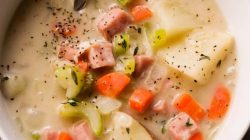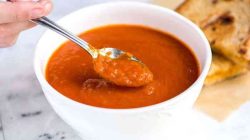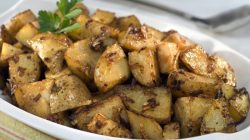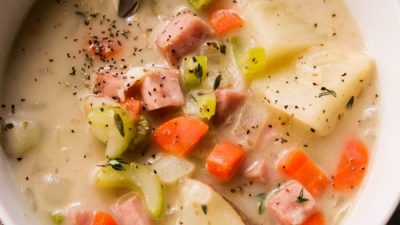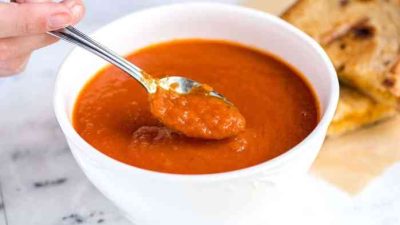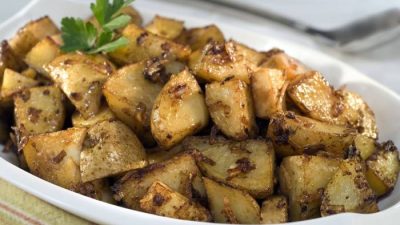Understanding Chicken Carcass Soup Basics
Recipe for chicken soup from carcass – Chicken carcass soup, often overlooked, offers a depth of flavor and nutritional benefits unmatched by soups made with only breast meat. This section will explore the advantages of using a chicken carcass, its nutritional profile, and the flavor differences compared to breast meat-based soups. We’ll also cover the essential equipment needed to embark on this culinary journey.
Benefits and Nutritional Value of Chicken Carcass Soup
Using a chicken carcass for soup yields a richer, more flavorful broth due to the concentration of collagen and connective tissues within the bones. This collagen breaks down during cooking, resulting in a thicker, more gelatinous consistency and a deeper, savory taste. The bones themselves are a good source of minerals like calcium, phosphorus, and magnesium. Compared to breast meat, the carcass provides a more complete nutritional profile, including these essential minerals often lacking in leaner cuts.
Flavor Profile Comparison: Carcass vs. Breast Meat
Chicken breast meat, while lean and tender, lacks the inherent depth of flavor found in the carcass. Soups made with only breast meat tend to be lighter and less savory. A carcass-based soup, on the other hand, offers a complex, umami-rich flavor profile, enhanced by the slow extraction of flavor compounds during cooking. The longer the cooking time, the more intense the flavor becomes.
Essential Equipment for Chicken Carcass Soup, Recipe for chicken soup from carcass
Having the right tools makes the process significantly easier and more efficient. Below is a list of essential equipment, along with alternatives and helpful notes.
| Equipment | Purpose | Alternatives | Notes |
|---|---|---|---|
| Large Stockpot or Dutch Oven | For simmering the soup | Slow cooker, pressure cooker | Choose a pot with a capacity of at least 6 quarts |
| Colander | For straining the broth | Fine-mesh sieve | Essential for removing solids from the broth |
| Wooden Spoon or Spatula | For stirring and skimming | Silicone spatula | Avoid metal utensils to prevent scratching the pot |
| Cutting Board and Sharp Knife | For preparing the carcass and vegetables | N/A | Safety is paramount; always use caution when handling knives |
Preparing the Chicken Carcass
Proper cleaning and preparation of the chicken carcass are crucial for achieving a flavorful and clear broth. This section details the process of cleaning, roasting (optional), and breaking down the carcass for optimal cooking.
Cleaning and Preparing a Raw Chicken Carcass
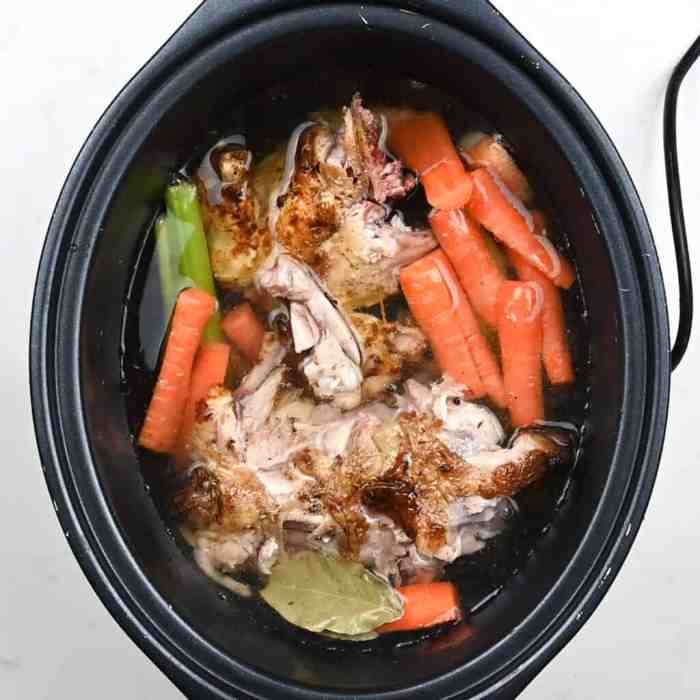
Source: supergoldenbakes.com
Begin by rinsing the raw chicken carcass thoroughly under cold running water. Remove any remaining feathers, skin, or excess fat. It’s important to inspect the carcass for any impurities before proceeding. Any noticeable imperfections should be removed. Pat the carcass dry with paper towels before proceeding to the next step.
Roasting Methods for Enhanced Flavor
Roasting the carcass before simmering adds a layer of depth and richness to the soup. Here are a few methods:
- Oven Roasting: Preheat oven to 400°F (200°C). Place the carcass on a roasting rack set over a baking sheet. Roast for 45-60 minutes, or until lightly browned. This method caramelizes the surface, enhancing the flavor of the broth.
- Pan Roasting: Heat a large skillet over medium-high heat. Sear the carcass on all sides until lightly browned. This method develops a rich, savory flavor through the Maillard reaction.
Removing Excess Fat and Impurities
After roasting (or before if not roasting), carefully remove any visible excess fat from the carcass. This step is crucial for preventing the soup from becoming overly greasy. Inspect the carcass once more for any remaining impurities, such as small bone fragments or feathers, and remove them.
Breaking Down the Carcass
To ensure even cooking and easier extraction of flavor, break down the carcass into smaller, manageable pieces. Use a cleaver or a heavy knife to separate the legs, wings, and back from the breastbone. This also allows for better penetration of heat and faster cooking times.
Choosing Ingredients and Flavor Profiles
The selection of vegetables and seasonings significantly impacts the overall taste and nutritional value of your chicken carcass soup. This section explores common vegetables, three distinct flavor profiles, and the role of herbs and spices.
Common Vegetables and Their Culinary Roles
A variety of vegetables can enhance the flavor and nutritional profile of your chicken soup. Here’s a table outlining common choices:
| Vegetable | Role in Soup | Substitutions | Preparation Method |
|---|---|---|---|
| Celery | Adds subtle sweetness and aromatics | Parsnips, carrots | Chopped roughly |
| Carrots | Provides sweetness and color | Sweet potatoes, turnips | Chopped roughly |
| Onion | Adds depth of flavor and savory notes | Leeks, shallots | Chopped roughly |
| Garlic | Enhances savory notes and adds pungency | Ginger | Crushed or minced |
Three Distinct Flavor Profiles
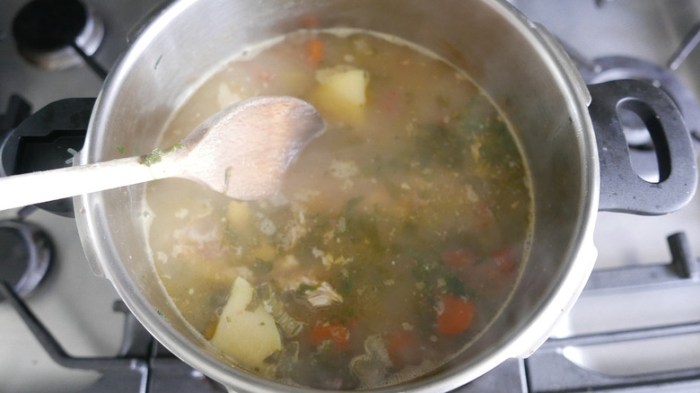
Source: tastingtable.com
The versatility of chicken carcass soup allows for creative exploration of different flavor profiles. Here are three examples:
- Classic: Simple and elegant, featuring carrots, celery, onion, and a bay leaf. This profile emphasizes the natural savory flavors of the chicken and vegetables.
- Spicy: Incorporates chili flakes, cayenne pepper, or a diced jalapeño for a fiery kick. Ginger and garlic can complement the spice.
- Herb-Infused: Highlights fresh herbs like thyme, rosemary, parsley, and dill. This profile offers a brighter, more aromatic flavor profile.
Impact of Herbs and Spices
Herbs and spices are key to creating nuanced flavor profiles. Thyme and rosemary offer earthy notes, while parsley and dill provide a fresh, herbaceous contrast. Spices like black pepper, cumin, and coriander can add warmth and complexity.
Alternative Ingredients for Richness and Complexity
To enhance the richness and complexity of the soup, consider adding ingredients like mushrooms (for an earthy umami flavor), lentils or barley (for added texture and nutrients), or a splash of white wine or sherry (for depth of flavor).
Cooking Methods and Techniques
Several methods can be employed to cook chicken carcass soup, each offering unique advantages and disadvantages. This section details a slow cooker method and compares different cooking approaches.
Step-by-Step Slow Cooker Method
- Place the prepared chicken carcass and vegetables in a slow cooker.
- Add water or broth to cover the ingredients completely.
- Season with salt, pepper, and any desired herbs and spices.
- Cook on low for 8-10 hours, or on high for 4-6 hours, until the chicken is very tender and the broth is flavorful.
- Remove the chicken from the broth and shred the meat.
- Strain the broth through a colander or fine-mesh sieve to remove solids.
- Return the shredded chicken to the broth and simmer for another 15-20 minutes.
Comparison of Cooking Methods
| Method | Advantages | Disadvantages | Time Required |
|---|---|---|---|
| Slow Cooker | Hands-off cooking, even heat distribution, excellent for developing flavor | Longer cooking time, less control over temperature | 8-10 hours (low), 4-6 hours (high) |
| Stovetop | More control over temperature and cooking process, faster cooking time | Requires more attention, potential for scorching | 2-3 hours |
| Pressure Cooker | Fastest cooking time, excellent for tenderizing bones | Can be less flavorful than slow cooker or stovetop methods | 1-1.5 hours |
Adjusting Cooking Time for Broth Consistency
To achieve a thicker broth, simmer the soup for a longer period, allowing more collagen to break down. For a thinner broth, reduce the cooking time. The desired consistency will depend on personal preference.
Skimming Fat
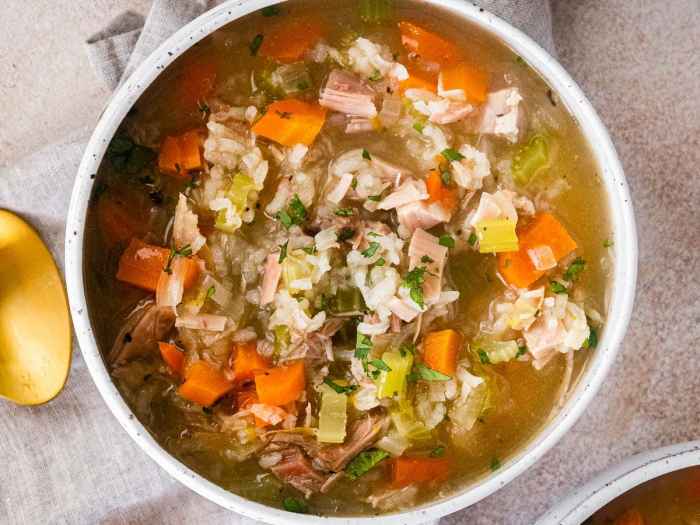
Source: dinnerthendessert.com
Skim excess fat from the surface of the soup periodically during cooking, using a spoon or ladle. This helps to maintain a cleaner, less greasy broth. Allow the soup to cool completely before skimming off any remaining fat on the surface.
Serving and Storage Suggestions: Recipe For Chicken Soup From Carcass
Proper serving and storage are essential for maximizing the enjoyment and longevity of your chicken carcass soup. This section provides guidance on garnishes, storage, repurposing, and visually appealing serving styles.
Suitable Garnishes
- Fresh herbs (parsley, chives, dill)
- Shredded chicken
- Lemon wedges
- Croutons
- Chopped green onions
Proper Storage
Allow the soup to cool completely before storing in airtight containers in the refrigerator for up to 3-4 days. For longer storage, freeze the soup in freezer-safe containers for up to 3 months.
Repurposing Leftover Soup
Leftover chicken carcass soup can be used as a base for other dishes, such as chicken pot pie filling, creamy chicken and rice casserole, or as a flavorful addition to pasta dishes.
Visually Appealing Serving Styles
Serve the soup in attractive bowls, garnished with fresh herbs and a swirl of cream or a drizzle of olive oil. Consider adding a side of crusty bread for dipping.
Variations and Adaptations
The basic chicken carcass soup recipe can be easily adapted to suit various dietary needs and preferences. This section explores variations for different diets and the incorporation of additional ingredients.
Dietary Adaptations
For a low-sodium version, reduce or omit the added salt and use low-sodium broth. For a gluten-free option, ensure all ingredients are gluten-free.
Adding Grains
Noodles, rice, or other grains can be added during the last 15-20 minutes of cooking to absorb the flavorful broth. Choose grains that cook quickly and complement the soup’s overall flavor profile.
Incorporating Other Meats or Poultry
Experiment with adding other meats or poultry, such as turkey, duck, or even beef bones, to create unique flavor combinations.
Seasonal Vegetable Variation
Incorporate seasonal vegetables such as butternut squash in the fall, asparagus in the spring, or zucchini in the summer to create a fresh, seasonal twist on the classic recipe.
FAQ Section
Can I use frozen chicken carcass?
Yes, but thaw it completely before use to ensure even cooking.
How long can I store leftover soup?
Store properly refrigerated in airtight containers for up to 4 days.
Can I make this soup in a pressure cooker?
Yes, pressure cooking significantly reduces cooking time. Refer to your pressure cooker’s instructions for specific timings.
What if my soup is too salty?
Making chicken soup from a carcass yields a deeply flavorful broth, rich in collagen. The process is similar in some ways to preparing other hearty broths, such as the delicious recipe beef noodle soup , though beef bones offer a distinctly different taste profile. Ultimately, both recipes highlight the power of simmering bones to create a nourishing and satisfying base for a comforting soup.
Add more water or vegetables to dilute the saltiness. You could also add a peeled potato to absorb some of the salt.




